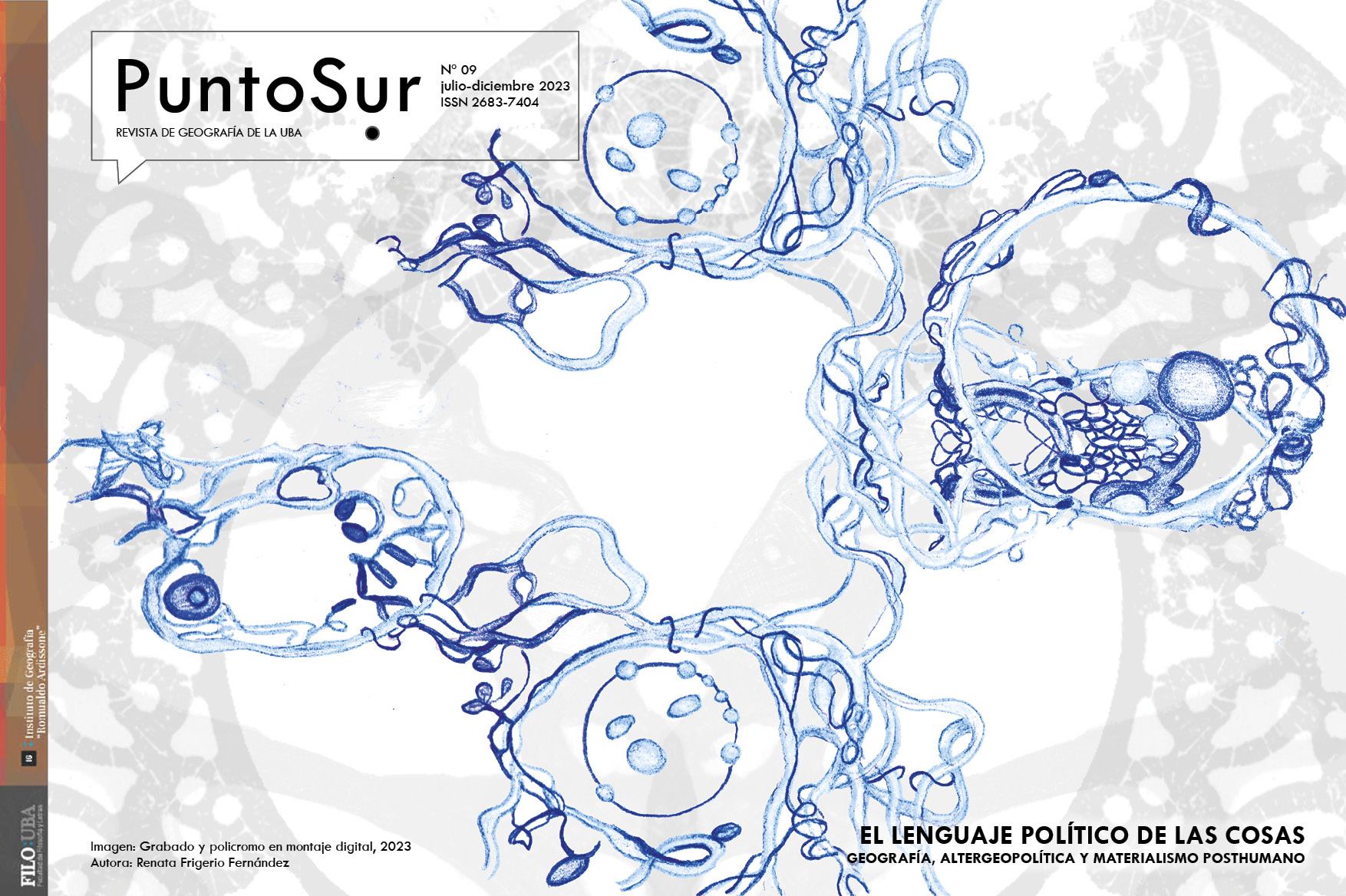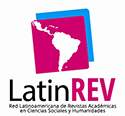Infrastructures and collapses of State expansion in the mountainous lands of central Chile
Prelude to an announced sacrifice
Abstract
Landmarks, monoliths, installations, and infrastructures in the most diverse states of conservation and use are part of the archaeological inventory of State presence in the Cordillera territories. This presence is divided between the installations of modernization of the territory at the expense of colonization of the environment and symbolic space, as well as the constructions deployed by inhabitants on the state expansion. In this case, our attention is focused on the former. The succession of public interventions in the more than two hundred years of the nation is symptomatic of the spasmodic ways in which hegemony is installed, maintained, and renewed in the mountain world. The legacy of installations that became traces and the irregular and unfinished geometric framework that remains, materialized in the successive transformations of the regional landscape, contribute to the understanding of the operational effectiveness of meager state formations. Our attention is focused on modernizing processes associated with rail transport, tourism, hydroelectricity generation and irrigation reservoirs, initiatives hegemonized by the presence of the Colbún hydroelectric power plant. All these initiatives have been promoted and sustained by the State and their traces have been metabolized in the current landscape that the State has converted into territory over the last two centuries.Downloads
References
Anand, N. (2015). Accretion. Recuperado el 24 de julio de 2022, desde Society for Cultural Anthropology website: https://culanth.org/fieldsights/accretion
Arnold, T. (2012). Conceptualization of river flows around the Ancoa Dam, Data from Irrigation in Chile, Region VII. Consultado de Wikimedia Commons en https://commons.wikimedia.org/wiki/File:Canalmelado.svg
Barriga, A. (2006). Ser o no ser campesino: Una mirada antropológica al turismo rural. Tesis de grado. Santiago: Universidad Academia de Humanismo Cristiano.
Bear, L. (2016). Time as Technique. Annual Review of Anthropology, 45(1), 487-502. https://doi.org/10.1146/annurev-anthro-102313-030159
Berque, A. (2007). Lieu et authenticité. Cahiers de Géographie du Québec, 142, 49-66.
Billé, F. (Ed.). (2020). Voluminous states: Sovereignty, materiality, and the territorial imagination. Durham: Duke University Press.
Bourdieu, P. (1972). Esquisse d’une Théorie de la Pratique. Genève: Droz.
Certeau, M. de. (2000). La invención de lo cotidiano. V.1. Artes de hacer (1ra ed.). Universidad Iberoamericana, Departamento de Historia: Instituto Tecnológico y de Estudios Superiores de Occidente.
Centro de Información de Recursos Naturales (CIREN) (1986). Evaluación Proyecto de embalse Ancoa. Ministerio de Agricultura. Santiago. https://docplayer.es/80505750-Proyecto-de-embalse-ancoa-evaluacion.html
Clastres, P. (1974). La société contre l’État: Recherches d’anthropologie politique. París: Éditions de minuit.
Cooperativa digital. (2023, julio 1). Bombero fue encontrado sin vida tras ocho días desaparecido en el Río Ancoa. Recuperado el 24 de julio de 2023, de Cooperativa.cl website: https://cooperativa.cl/noticias/pais/organismos/bomberos/bombero-fue-encontrado-sin-vida-tras-ocho-dias-desaparecido-en-el-rio/2023-07-01/131409.html
Correa Cabrera, M. (2021). La historia del despojo: El origen de la propiedad particular en el territorio mapuche (Primera edición). Ñuñoa: Pehuén.
Creswell, P. (2004). Place. A Short Introduction. Londres: Blackwell.
Delpiano V., C. (2014). Canal de Melado, Memoria del año 1926. Anales Del Instituto De Ingenieros De Chile, (6), Pág. 238–244. Recuperado el 4 de marzo de 2023 desde https://revistas.uchile.cl/index.php/AICH/article/view/34383
Derrida, J. (2019). De la gramatología. Ciudad de México: Siglo XXI.
DeSilvey, C. (2017). Curated Decay: Heritage Beyond Saving. Minneapolis: University of Minnesota Press.
Edgeworth, M. y Simonetti, C. (2022, abril 22). Concrete: A Stratigraphic Marker for the Anthropocene | Anthropocene Curriculum. Recuperado el 8 de septiembre de 2022, de Anthropocene Curriculum website: https://www.anthropocene-curriculum.org/contribution/concrete-a-stratigraphic-marker-for-the-anthropocene
Elden, S. (2013). The birth of territory. Chicago; Londres: The University of Chicago Press.
Espinoza Rivera, G.; Skewes, J. C.; Guerra, M, D. E. y Catalán Martina, E. (2023). Unraveling State governance in the Chilean Cordillera: Privatization, precariousness, and arrhythmia. Political Geography, 105. https://doi.org/10.1016/j.polgeo.2023.102922
Finn, J. L. (1998). Tracing the veins: Of copper, culture, and community from Butte to Chuquicamata. Berkeley: University of California Press.
Foucault, M. (2003). Vigilar y castigar. El nacimiento de la prisión. Buenos Aires: Siglo XXI.
Foucault, M. (2014). Seguridad, territorio, población: Curso en el Collége de France (1977-1978) (M. Senellart, F. Ewald, & A. Fontana, Eds.; H. Pons, Trad.). México, D.F.: Fondo de Cultura Económica.
Gartenlaub-González, A., & Tello-Navarro, F. (Eds.). (2021). El Maule hoy: Perspectivas y aproximaciones socio-históricas, económicas y medioambientales del Valle Central. Santiago: RIL Editores y Universidad Autónoma de Chile.
Giddens, A. (1984). The Constitution of Society. Cambridge: Polity Press.
Girón, N. (2008). La producción del espacio social de frontera y autonomía en la Región Pehuenche. En A. Arce, A. Corvalán, N. Girón, R. Jofré, J. Navarro y C. Pavez (eds.), Huellas Cordilleranas. Ensayo sobre memoria social en el valle superior del Maule y el sur cuyano (pp. 15-76). Santiago: Universidad Metropolitana de Ciencias de la Educación.
González Colville, J. (2018). Historia de Linares. Linares: I. Municipalidad de Linares.
Gordillo, G. (2014). Rubble: The afterlife of destruction. Durham: Duke University Press.
Graham, N. (2011). Lawscape: Property, environment, law. Abingdon, UK: Routledge.
Graham, S., y Marvin, S. (2001). Splintering urbanism: Networked infrastructures, technological mobilities and the urban condition. Londres y Nueva York: Routledge.
Grandin, G. (2009). Fordlandia: The rise and fall of Henry Ford’s forgotten jungle city. Nueva York: Picador.
Harvey, D. (1979). Monument and MYTH. Annals of the Association of American Geographers. Vol 69, No. 3. 362 -381://www.jstor.org/stable/2562969
Hill, J. (2017). Circuits of State. Radical History Review, 2017(127), 13-38. https://doi.org/10.1215/01636545-3690846
Hobart, A. y Kapferer, B. (eds.) (2012). Contesting the State The Dynamics of Resistance and Control. Londres: Sean Kingston Publishing.
Howe, C.; Lockrem, J.; Appel, H.; Hackett, E.; Boyer, D.; Hall, R.; Schneider-Mayerson, M.; Pope, A.; Gupta, A.; Rodwell, E.; Ballestero, A.; Durbin, T.; el-Dahdah, F.; Long, E. y Mody, C. (2015). Paradoxical Infrastructures: Ruins, Retrofit, and Risk. Science, Technology, & Human Values, 41(3), 547-565. https://doi.org/10.1177/0162243915620017
Huyssen, A. (2006). Nostalgia for Ruins. Grey Room, 6-21. https://doi.org/10.1162/grey.2006.1.23.6
Imágenes de Chile del 1900 (27 de agosto de 2013). Linares, Parral, Panimávida y Yerbas Buenas. Panimávida, Estación de Ferrocariles. http://1.bp.blogspot.com/-sZ9eKTznlfY/Uh08Ww16ivI/AAAAAAAADPk/V6nKqW5WBGc/s1600/1076+panimavida.jpg
Ingold, T. (1995). Building, dwelling, living. How animals and people make themselves at home in the world. In Strathern, Marilyn (Ed.), Shinfting context.Transformations in anthropological Knowledge (pp. 57-90). Routledge.
Jansen, S. (2018). Yearnings in the meantime: «normal lives» and the state in a Sarajevo apartment complex (First paperback edition). Nueva York: Berghahn.
Joseph, G. M. y Nugent, D. (eds.) (1994). Everyday forms of state formation: Revolution and the negotiation of rule in modern Mexico. Durham: Duke University Press.
Jouannais, J.-Y. y Monreal Salvador, J. R. (2017). El uso de las ruinas: Retratos obsidionales. Barcelona: Acantilado.
Katzer, L. (2021). Dinamizando el concepto de nomadismo. Notas teóricas y etnográficas sobre un modelo territorial no reconocido. Tabula Rasa, 37, 151-167. https://doi.org/10.25058/20112742.n37.07
Klubock, T. M. (2014). La frontera: Forests and ecological conflict in Chile’s frontier territory. Durham; Londres: Duke University Press.
Lefebvre, H. (2013). La producción del espacio (1a ed). Madrid: Capitán Swing.
Levy, J. y Lussault, M. (2003). Dictionnaire de la Géographie et de l’Éspace des Sociétés. París: Belin.
Liboiron, M. y Lepawsky, J. (2022). Discard studies: Wasting, systems, and power. Cambridge, Massachusetts; Londres: The MIT Press.
Magnet, A. (1964). Improa: Un modelo para una reforma agraria. Revista Mensaje, 131, 353-358. https://repositorio.uahurtado.cl/handle/11242/9910
Mah, A. (2017). Ruination and Post-Industrial Urban Decline, En S. Hall y R. Burdett (eds.), Sage Handbook of the 21st Century City (pp. 201-212). Londres: Sage.
Mansilla Sepúlveda, J.; Umbach, J.; Pozo Menares, G. y Canio Llanquinao, M. (eds.) (2020). La cruz capuchina en territorio mapuche: Educación y memoria fotográfica archivada en Altötting, Alemania. Ñuñoa, Santiago, Chile: Pehuén.
Marx, K. y Engels, F. (1974). La ideología alemana. Barcelona: Grijalbo.
Massey, D. B. (2012). For space. Londres: Sage.
Massumi, B. (2010). The Future Birth of the Affective Fact: The Political Ontology of Threat. En M. Gregg y G. J. Seigworth (eds.), The Affect Theory Reader (pp. 52-70). Duke University Press. https://doi.org/10.1215/9780822393047-002
Memoria Viva (2023). Escuela de Artillería de Linares. Centros de Detención. https://memoriaviva.com/nuevaweb/centros-de-detencion/vii-region/escuela-de-artilleria-de-linares/
Millakura. (2023). La represa. Recuperado el 24 de julio de 2023 de: https://youtu.be/V9WCoFjnE-Y
Mitchell, T. (1999). Society, Economy, and the State Effect. En State/Culture: State Formation after the Cultural Turn. (pp. 76-97). Ithaca: Cornell University Press.
NRDC (20 de octubre de 2020). La gran estafa hídrica: Reguemos Chile es una respuesta delirante y equivocada a la megasequía en Chile. Descargado el 10 de julio de 2023 desde: https://www.nrdc.org/sites/default/files/hydro-highway-robbery-reguemos-chile-ib-sp.pdf
Navarro, J. y Jofré, R. (2008). Procesos de construcción idenitaria en el Sistema Pehuenche Malargüe, El Melado y Armerillo. En A. Arce, A. Corvalán, N. Girón, R. Jofré, J. Navarro, C. Pavez (eds.), Huellas Cordilleranas. Ensayo sobre memoria social en el valle superior del Maule y el sur cuyano (pp. 88-107). Santiago: Universidad Metropolitana de Ciencias de la Educación.
Núñez González, A.; Aliste Almuna, E. y Bello Maldonado, Á. (2014). Patagonia-Aysén en la construcción del imaginario geográfico de la nación. Iztapalapa. Revista de Ciencias Sociales y Humanidades, 35(76), 165-188. https://doi.org/10.28928/ri/762014/aot2/nunezgonzaleza/alistealumnae/bellomaldonadoa
Ogden, L. (2021). Loss and wonder at the world’s end. Durham: Duke University Press.
Panez-Pinto, A.; Mansilla-Quiñones, P. y Moreira-Muñoz, A. (2018). Agua, tierra y fractura sociometabólica del agronegocio. Actividad frutícola en Petorca, Chile. Revista Bitácora Urbano Territorial, 28(3), 153-160.
Parra, V. A. (2022). Dicotomías entre planificación territorial y paisaje en la precordillera de la región del Maule, Colbún. Tesis de grado, Universidad de Concepción.
Peragallo Díaz, R. I. (2020). La producción estatal de las zonas de sacrificio en Chile: Un estudio en profundidad del caso de Quintero-Puchuncaví. Recuperado de https://repositorio.uc.cl/handle/11534/49522
Pinto Rodríguez, J. (2003). La formación del estado y la nación, y el pueblo mapuche: De la inclusión a la exclusión. Santiago, Chile: Dirección de Bibliotecas, Archivos y Museos: Centro de Investigaciones Diego Barros Arana.
Plataforma Urbana. (2013, mayo 27). Levantan puente sobre río Maule, el tercero más largo del país, Plataforma Urbana. Recuperado el 24 de julio de 2023, de https://www.plataformaurbana.cl/archive/2013/05/27/levantan-puente-sobre-rio-maule-el-tercero-mas-largo-del-pais/
Povinelli, E. A. (2001). Radical Worlds: The Anthropology of Incommensurability and Inconceivability. Annual Review of Anthropology, 30(1), 319-334. https://doi.org/10.1146/annurev.anthro.30.1.319
Ribeiro, D. (1992). Las Américas y la civilización: proceso de formación y causas del desarrollo desigual de los pueblos americanos. Biblioteca Ayacucho.
Rodríguez, W. y Sepúlveda, F. (2011). Impacto socioeconómico de las centrales hidroeléctricas en la cuenca media del río Maule. Tesis para optar a título de Profesor de Educación media Historia y Geografía, Universidad del Bío-Bío.
Sassen, S. (2014). Expulsions: Brutality and complexity in the global economy. Cambridge, Massachusetts: The Belknap Press of Harvard University Press.
Schwarcz, G. y Szőke, A. (2014). Creating the State Locally through Welfare Provision: Two Mayors, Two Welfare Regimes in Rural Hungary. Social Analysis, 58(3). https://doi.org/10.3167/sa.2014.580310
Scott, J. C. (2008). Seeing like a state: How certain schemes to improve the human condition have failed (Nachdr.). New Haven: Yale University Press.
Scott, J. C. (2009). The art of not being governed: An anarchist history of upland Southeast Asia. New Haven: Yale University Press.
Serge, M. (2011). El revés de la Nación. Territorios salvajes, fronteras y tierras de nadie (2da ed.). Bogotá: Ediciones Uniandes.
Serres, M. (2011). Malfeasance: Appropriation through pollution? (A.-M. Feenberg-Dibon, Trad.). Stanford, Calif: Stanford University Press.
Skewes, J. C.; Solari, M. E.; Guerra, D. E. y Jalabert, D. (2012). Los paisajes del agua. Naturaleza e identidad en la Cuenca del río Valdivia. Chungará. Revista de Antropología Chilena, 44(2), 309-312.
Skewes, J.; Guerra, D.; Rojas, P. y Mellado, M. (2011). ¿La memoria de los paisajes o los paisajes de la memoria? Los enigmas de la sustentabilidad socioambiental en las geografías en disputa. Desenvolvimento e Meio Ambiente, 23. 10.5380/dma.v23i0.20774.
Stilz, A. (2019). Territorial sovereignty: A philosophical exploration. Oxford: Oxford University Press.
Stoler, A. L. (2016). Duress: Imperial durabilities in our times. Durham y Londres: Duke University Press.
Stoler, A. L. (ed.) (2013). Imperial debris: On ruins and ruination. Durham y Londres: Duke University Press.
Thelen, T.; Vetters, L. y von Benda-Beckmann, K. (eds.). (2017). Stategraphy: Toward a Relational Anthropology of the State. Berghahn Books.
Thiesenhusen, W. C. (1974). Experimentos chilenos en Reforma Agraria: Nueva vista a cuatro proyectos de colonización. University of Wisconsin. Recuperado el 10 de enero de 2023 desde https://minds.wisconsin.edu/bitstream/handle/1793/56504/ltc097-s.pdf?sequence=1
Tsing, A.L. (2015). The mushroom at the end of the world: on the possibility of life in capitalist ruins. Princeton, New Jersey: Princeton University Press.
Tuan, Y.F. (1974). Topophilia. A Study of Environmental Perception, Attitudes, and Values. Englewood Cliffs (NJ): Prentice-Hall.
Vargas, E. (2021). El tren chico de Linares a Colbún. Recuperado el 10 de marzo de 2023 desde https://amigosdeltren.cl/tren-chico-linares-Colbún
Velho, R. y Ureta, S. (2019). Frail modernities: Latin American infrastructures between repair and ruination. Tapuya: Latin American Science, Technology and Society, 2(1), 428-441. https://doi.org/10.1080/25729861.2019.1678920
Villarroel, F. C. (2013). La “chilenización” en el Norte y Sur de Chile: Una necesaria revisión. Cuadernos Interculturales, 11(20), 11-43.
Wagner, J. y Frisch, M. (eds.) (2014). New Orleans and the Design Moment. Routledge. https://doi.org/10.4324/9781315873343
Copyright (c) 2023 Juan Carlos Skewes, Gabriel Esteban Espinoza Rivera

This work is licensed under a Creative Commons Attribution 4.0 International License.

 Important notice
Important notice




















